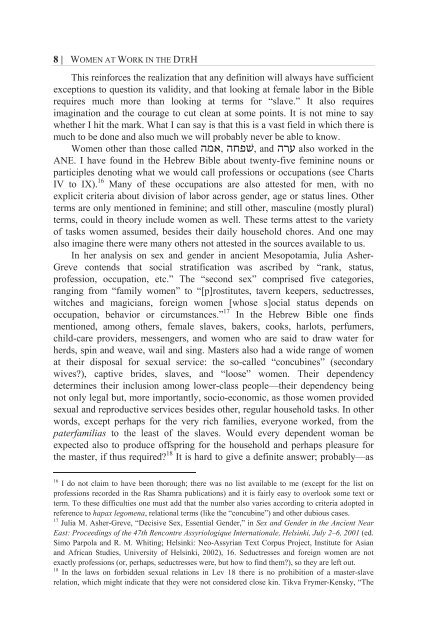Women at Work in the Deuteronomistic History - International Voices ...
Women at Work in the Deuteronomistic History - International Voices ...
Women at Work in the Deuteronomistic History - International Voices ...
You also want an ePaper? Increase the reach of your titles
YUMPU automatically turns print PDFs into web optimized ePapers that Google loves.
8 | WOMEN AT WORK IN THE DTRH<br />
This re<strong>in</strong>forces <strong>the</strong> realiz<strong>at</strong>ion th<strong>at</strong> any def<strong>in</strong>ition will always have sufficient<br />
exceptions to question its validity, and th<strong>at</strong> look<strong>in</strong>g <strong>at</strong> female labor <strong>in</strong> <strong>the</strong> Bible<br />
requires much more than look<strong>in</strong>g <strong>at</strong> terms for “slave.” It also requires<br />
imag<strong>in</strong><strong>at</strong>ion and <strong>the</strong> courage to cut clean <strong>at</strong> some po<strong>in</strong>ts. It is not m<strong>in</strong>e to say<br />
whe<strong>the</strong>r I hit <strong>the</strong> mark. Wh<strong>at</strong> I can say is th<strong>at</strong> this is a vast field <strong>in</strong> which <strong>the</strong>re is<br />
much to be done and also much we will probably never be able to know.<br />
<strong>Women</strong> o<strong>the</strong>r than those called המא, החפשׁ, and הרע also worked <strong>in</strong> <strong>the</strong><br />
ANE. I have found <strong>in</strong> <strong>the</strong> Hebrew Bible about twenty-five fem<strong>in</strong><strong>in</strong>e nouns or<br />
participles denot<strong>in</strong>g wh<strong>at</strong> we would call professions or occup<strong>at</strong>ions (see Charts<br />
IV to IX). 16 Many of <strong>the</strong>se occup<strong>at</strong>ions are also <strong>at</strong>tested for men, with no<br />
explicit criteria about division of labor across gender, age or st<strong>at</strong>us l<strong>in</strong>es. O<strong>the</strong>r<br />
terms are only mentioned <strong>in</strong> fem<strong>in</strong><strong>in</strong>e; and still o<strong>the</strong>r, mascul<strong>in</strong>e (mostly plural)<br />
terms, could <strong>in</strong> <strong>the</strong>ory <strong>in</strong>clude women as well. These terms <strong>at</strong>test to <strong>the</strong> variety<br />
of tasks women assumed, besides <strong>the</strong>ir daily household chores. And one may<br />
also imag<strong>in</strong>e <strong>the</strong>re were many o<strong>the</strong>rs not <strong>at</strong>tested <strong>in</strong> <strong>the</strong> sources available to us.<br />
In her analysis on sex and gender <strong>in</strong> ancient Mesopotamia, Julia Asher-<br />
Greve contends th<strong>at</strong> social str<strong>at</strong>ific<strong>at</strong>ion was ascribed by “rank, st<strong>at</strong>us,<br />
profession, occup<strong>at</strong>ion, etc.” The “second sex” comprised five c<strong>at</strong>egories,<br />
rang<strong>in</strong>g from “family women” to “[p]rostitutes, tavern keepers, seductresses,<br />
witches and magicians, foreign women [whose s]ocial st<strong>at</strong>us depends on<br />
occup<strong>at</strong>ion, behavior or circumstances.” 17 In <strong>the</strong> Hebrew Bible one f<strong>in</strong>ds<br />
mentioned, among o<strong>the</strong>rs, female slaves, bakers, cooks, harlots, perfumers,<br />
child-care providers, messengers, and women who are said to draw w<strong>at</strong>er for<br />
herds, sp<strong>in</strong> and weave, wail and s<strong>in</strong>g. Masters also had a wide range of women<br />
<strong>at</strong> <strong>the</strong>ir disposal for sexual service: <strong>the</strong> so-called “concub<strong>in</strong>es” (secondary<br />
wives?), captive brides, slaves, and “loose” women. Their dependency<br />
determ<strong>in</strong>es <strong>the</strong>ir <strong>in</strong>clusion among lower-class people—<strong>the</strong>ir dependency be<strong>in</strong>g<br />
not only legal but, more importantly, socio-economic, as those women provided<br />
sexual and reproductive services besides o<strong>the</strong>r, regular household tasks. In o<strong>the</strong>r<br />
words, except perhaps for <strong>the</strong> very rich families, everyone worked, from <strong>the</strong><br />
p<strong>at</strong>erfamilias to <strong>the</strong> least of <strong>the</strong> slaves. Would every dependent woman be<br />
expected also to produce offspr<strong>in</strong>g for <strong>the</strong> household and perhaps pleasure for<br />
<strong>the</strong> master, if thus required? 18 It is hard to give a def<strong>in</strong>ite answer; probably—as<br />
16 I do not claim to have been thorough; <strong>the</strong>re was no list available to me (except for <strong>the</strong> list on<br />
professions recorded <strong>in</strong> <strong>the</strong> Ras Shamra public<strong>at</strong>ions) and it is fairly easy to overlook some text or<br />
term. To <strong>the</strong>se difficulties one must add th<strong>at</strong> <strong>the</strong> number also varies accord<strong>in</strong>g to criteria adopted <strong>in</strong><br />
reference to hapax legomena, rel<strong>at</strong>ional terms (like <strong>the</strong> “concub<strong>in</strong>e”) and o<strong>the</strong>r dubious cases.<br />
17 Julia M. Asher-Greve, “Decisive Sex, Essential Gender,” <strong>in</strong> Sex and Gender <strong>in</strong> <strong>the</strong> Ancient Near<br />
East: Proceed<strong>in</strong>gs of <strong>the</strong> 47th Rencontre Assyriologique Intern<strong>at</strong>ionale, Hels<strong>in</strong>ki, July 2–6, 2001 (ed.<br />
Simo Parpola and R. M. Whit<strong>in</strong>g; Hels<strong>in</strong>ki: Neo-Assyrian Text Corpus Project, Institute for Asian<br />
and African Studies, University of Hels<strong>in</strong>ki, 2002), 16. Seductresses and foreign women are not<br />
exactly professions (or, perhaps, seductresses were, but how to f<strong>in</strong>d <strong>the</strong>m?), so <strong>the</strong>y are left out.<br />
18 In <strong>the</strong> laws on forbidden sexual rel<strong>at</strong>ions <strong>in</strong> Lev 18 <strong>the</strong>re is no prohibition of a master-slave<br />
rel<strong>at</strong>ion, which might <strong>in</strong>dic<strong>at</strong>e th<strong>at</strong> <strong>the</strong>y were not considered close k<strong>in</strong>. Tikva Frymer-Kensky, “The




